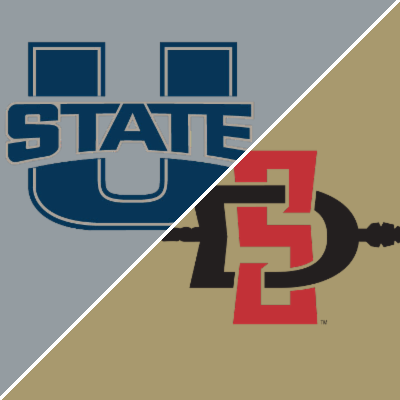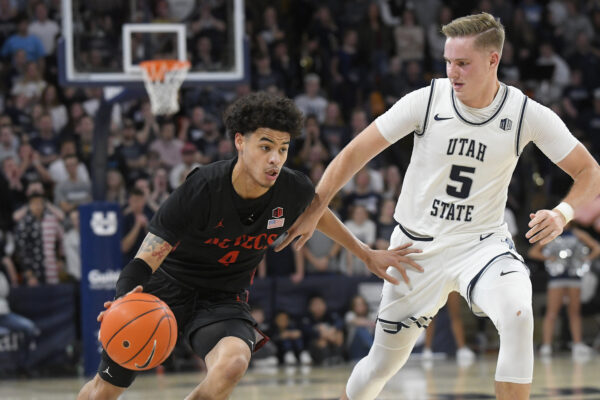The Lore of the “I Believe” chant and SDSU vs Utah State Preview

NCAA Logo

One of the more iconic moments of every San Diego State home game is when the leaders of The Show climb the podium to lead 12,414 fans in the “I Believe” chant.
Created elsewhere, but popularized by SDSU’s student section in 2011, the chant has become a fixture at sporting events across the nation. Thursday, the San Diego Men’s Basketball Team will experience their first live rendition of the chant.
Utah State, of course, claims the chant as their own.
The Desert News ran an article in 2014 describing the event at The Spectrum and its adoption by their student section, the Hurd. When the school first started using the chant, however, the Aggies’ relegation to the Western Athletic Conference meant The Hurd went unheard nationally, so the branding of the chant remained open. It was not until the rivalry between SDSU and BYU – Kawhi vs. Jimmer – captured the attention of the country that the chant was noticed around the world. Thus, the chant is more affiliated with San Diego State.
If anyone deserves an exemption from the Governor’s order on fans attending the game, it would be the current student leaders of The Show – Chase Osborn, Haley Simpson, Chase Karlo, Brooklyn Monet, and Devin Whatley – who volunteer their time and energy to unify the campus around the school’s sports teams. Thursday and Saturday, SDSU’s Men’s Basketball team will have to endure a less spirited rendition of chant now synonymous with their own school than the one provided at home games.
The state of Utah permits about 1,500 fans in the arena, and if listening closely, a few of the Hurd will be heard using the Aztec’s chant. Perhaps, just before this pre-game ritual, SDSU’s players can close their eyes and imagine for just a moment it is Osborn, Simpson, Karlo, Monet, and Whatley, leading the chant, and for that brief second, remember the feeling of Aztec Nation in unison jumping and shouting, “I believe that we will win!”
Three Keys to an SDSU Victory
1. 50/50 Balls and Rebounding
SDSU and USU are very similar. On offense, they both like to push the pace of the game and hunt for the first good shot regardless of how much time is on the shot clock. Defensively, they are both anchored by dominant shot-blockers surrounded by active, physical defenders who force their oppositions to take shots late in the possession.
“It’s more of a chess match — see what players on the court can figure things out, can do something a little bit different,” senior forward Matt Mitchell said when asked what playing the same team twice in three days is like. “Maybe break off of a play and get a bucket for their team. When it comes down to it, a lot of the teams in this conference are tough —like Nevada, like Utah State coming up. So, it’ll likely be situations where we’ll have to come into it (where) maybe a play won’t work because Utah State knows our plays…we might have to break off a play and find a way to get a bucket.”
Those unscripted plays Mitchell described often come when a player makes a play on a loose ball or on a rebound – especially an offensive rebound. In both of these areas, the Aggies may have an advantage because of the play of junior forward Justin Bean. Bean leads the conference in offensive rebounds and is fourth in defensive rebounds.
“The thing they do better than most in the country is rebound the ball,” Coach Dutcher explained at the Aztecs’ weekly press conference. “They’re probably in the top ten in the country rebounding the ball both offensively and defensively, so we’re going have to box out. We’re going to do a good job of keeping them off the glass.”
As great as Bean is rebounding the ball, it is his ability to find the ball when both teams have an equal chance that makes him unique. Utah State’s offense could be described as organized chaos with the amount of movement the Aggies employ. In the creases and cracks of this movement, Bean thrives. How will the Aztecs ensure they match Bean and the Aggies in this regard?
“That starts in practice,” Mitchell said. “We talked about that for all of our previous games. 50/50 balls — especially the last game — Nevada seemingly came up with most of the balls that were lingering or maybe a ball that bounced one way…it’s maybe more mentality in that way and putting effort into it and just going for the ball. I think that’s all there is to it. You just have to come into it with a hard hat mindset and be ready to go. Justin Bean and these guys are very well rounded and hard-working players. I’ve played against Bean these last two years, and getting a feel for him and know he’s a hard-nosed player. (He) wants to rebound the ball, get it on the floor, and get that confidence boost for his team. Getting to that ball first will be big time for us, especially on the road.”
2. Mensah vs. Queta
Who is the greatest basketball player of all time? Lebron James or Michael Jordan? Proponents of Jordan’s claim to the throne point to his greater number of titles and the way Jordan took the NBA to become the global empire it is today. In turn, James’ fans claims his spot at the top for the way he changed the game.
Despite players like Magic Johnson, it was not until James entered the league that teams around the NBA allowed their taller players more freedom.
“I prefer ‘position-less basketball.’” Mitchell explained. “I think that’s the guy I am. I’m a one through four kind of guy on offense and defense. I wouldn’t say I really have one solid position on this team, and I think everyone would say the same.”
Mitchell may have James to thank for the opportunity to play with that flexibility.
Thursday and Saturday provide a glimpse at basketball the way it was played before James revolutionized the game. Certainly, the two best centers in the Mountain West, Nathan Mensah and Neemias Queta are possibly the West Coast’s best centers.
“We’re seeing one of the top centers not only in our league but in the country,” Coach Dutcher said.
Their matchup during the series will go a long way in determining the outcome. Queta leads Mensah in every statistical category but is required to do more for his team.
“Obviously, Queta gets the majority of the touches,” Coach Dutcher explained in devising his game plan for the series. “He scores the ball inside, but the thing he does better than most people in the country is getting assists. He’s their leading assist man. When your leading assist man is your center, that creates problems for the opposition, so he can score, and he can pass out of the low post. He’ll provide a great challenge.”
There are so many elements to this matchup that extends beyond the times when they face each other in the post. Utah State likes to use Queta as the double in the post. Will they be able to play one on one when Mitchell has the ball down low, or will they have to send Queta to get the ball out of his hands? If they do, can SDSU take advantage by finding Mensah?
Likewise, when either player leaves their man to block a shot, it leaves the other to clean up the offensive glass. Mensah’s collected his most offensive rebounds against Arizona State because his man left him to block shots.
“That’s been a great matchup — Nathan against (Queta).” Dutcher said. “They both have battled hard. Baskets are not easy to come by. Obviously, Nathan did not get a chance last year to go against him. I just remember the freshman year when they battled so hard. It’ll be good to see Nathan and he going head to head again. Obviously, it’s not an individual matchup that will decide the game. It’ll be team defense, team offense. But that will be two really good post players going after each other.”
3. Playing at altitude
“The research shows that if you can play within 24-36 hours of arriving,” Coach Dutcher said, describing the challenge of playing at altitude. “The effects are not as great as once you’re there past that time frame. It takes two weeks to acclimate. When we play that second game, I’m sure we’ll see some effects. It won’t be anything where you’re looking out there, and guys are falling down tired. It might produce a half step where we’re not where we are supposed to be, and that can determine the game.”
One aspect of the new scheduling format adopted by the Mountain West is it forces teams to be in altitude longer than would if they were only one game. Of course, each person’s body is different, but generally speaking, this should be a tremendous advantage for the Aggies on Saturday, possibly making the Thursday matchup a must-win for the Aztecs. How does SDSU combat the effects of altitude?
Beet juice.
Playing at altitude decreases the amount of oxygen that reaches the lungs, blood, and ultimately the body’s tissues. Beet juice increases the amount of nitric oxide in the body. Nitric oxide has been shown to decrease the amount of oxygen needed when the body is working.
“I think that second game will definitely be a little bit tougher,” Mitchell explained at Monday’s press conference. “Not living at altitude. We’ll just have to take the right precautions, and Sergio (Ibarra) has already taken the first step in making beet juice for us, which is good in altitude. Our trainers and our coaching staff will take the right measure, helping our guys to be healthy and not get tired so quick. It’s all fight fatigue. As Dutch says, ‘Mental toughness, extra effort.’”
My earliest sport’s memory involve tailgating at the Murph, running down the circular exit ramps, and seeing the Padres, Chargers and Aztecs play. As a second generation Aztec, I am passionate about all things SDSU. Other interests include raising my four children, being a great husband and teaching high school.